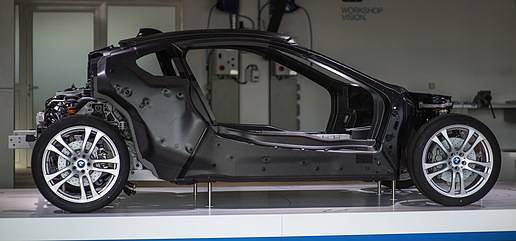 研究表明,一种新型“可逆性”胶水可让修复/重连后的粘接更加牢固。(图片来源:美国化学理事会)
研究表明,一种新型“可逆性”胶水可让修复/重连后的粘接更加牢固。(图片来源:美国化学理事会) 这种可逆性粘合剂可以在车辆的维修保养和报废回收过程中发挥巨大作用,特别是对BMW i8 等大量采用碳纤维增强材料的车型来说,尤其如此。(图片来源:BMW)
这种可逆性粘合剂可以在车辆的维修保养和报废回收过程中发挥巨大作用,特别是对BMW i8 等大量采用碳纤维增强材料的车型来说,尤其如此。(图片来源:BMW) 
日前,ACC美国化学理事会 (American Chemistry Council) 和美国密歇根州立大学 (MSU) 的研究人员展示了一种新型“可逆性”多材料连接粘合剂。这种粘合剂的特别之处可以让修复/重连之后的粘接更为牢固,而这种特性将极大地便利一些大量采用碳纤维增强材料 (CFRP) 车型的维修保养和报废回收。
在美国密歇根州特拉弗斯市举办的管理研讨会 (MBS) 期间,美国索尔维特种聚合物 (Solvay Specialty Polymers) 公司汽车业务发展经理、美国化学理事会汽车工作组现任轮值主席 Sandra McClelland表示,“今年,研究人员发现,我们可以使用这种粘合剂进行部件粘合,而后将粘合的部件分离,最后再次进行二次粘合,而‘愈合’后的新连接甚至比第一次粘合更加牢固。这意味着,经过这种胶水的修复,一个在车祸中受到损坏的碳纤维车架可能比碰撞之前更加结实,而里程已经 50,000 英里的车辆进行修复,车辆的碳纤维车架甚至比出厂时更加结实。”
McClelland 介绍了索尔维公司与密歇根州立大学复合汽车研究中心 (Composite Vehicle Research Center) 及 Mahmoodul Haq 博士在可逆性多材料粘接合作研究项目中的最新发现。这种新型粘接剂的研发,主要是为了满足汽车行业对连接技术的多项要求,包括:不同材料(塑料、钢、铝和复合材料)的连接、车辆减重、连接牢固性(ASTM 美国材料与试验协会的结构效率测试)、45 秒内完成粘接工序,以及连接过程可逆等。也就是说,粘接后的部件可以在当地车厂的维修保养环节中分离,并“重新进行连接”,使车辆报废后的复合材料回收也将更加便捷快速。
在管理研讨会上,McClelland 表示,这种“神奇的胶水”是美国化学理事会和密歇根州立大学的联合研究成果,目前看来可以满足汽车行业的上述各种要求。这种热塑性粘合剂的另一个特殊之处在于,可以将需要连接的组件接缝完全连接在一起,而非仅连接部分粘接点。此外,由于连接处的扩展应力“相当强”,厂商还可以显著减少这种粘合剂的用量,从而实现额外的车辆减重效果。
可逆性过程
McClelland 表示,这种热塑性粘接剂可以在不到 1 分钟内完成融化、分离、重连的完整过程,完全符合车辆装配厂对粘接工艺的速度要求。具体来说,这种可逆性粘接剂内含大量磁性纳米铁微球,而这些金属纳米颗粒将在电流通过时产生振动,并在几秒内快速升温至很高的温度(300 到 800°F 之间),从而在周围材料开始变热之前完成融化分离过程。此后,这种粘合剂还可以在几秒钟内硬化,也就是从本质上成为了一种可是随时满足融化分离和重新粘接需求的“快干胶水”。
密歇根州立大学的研究人员首先使用加热的粘接剂连接多种不同材料,而后对这些连接处进行了失效测试,并按照 ASTM 协会对抗疲劳强度、剪切应力、冲击应力、弯曲蠕变模量等参数的标准,评估这些连接处的结构效率。此后,研究人员利用电磁线圈在 30 秒内重新融化粘合剂,并对“愈合”后的新连接进行平行重复试验。数据表明,新形成的连接更牢固。
McClelland 表示,“通过融化粘合剂并重新赋予它所需的能量,新连接的结晶程度比之前更高,而聚合物的结晶程度可以在一定程度上决定该聚合物的强度。”
McClelland补充说,研发人员将首先尝试降低这种粘接剂的成本,然后逐步进行商业化推广,但目前尚未制定具体的时间计划。
据 McClelland介绍,“这种粘接剂具备在修复后更加牢固的特点,可以在一定程度上解决汽车行业所面对的‘连接点’疲劳问题。”
The American Chemistry Council (ACC) and researchers at Michigan State University (MSU) have demonstrated a new “reversible” adhesive for multi-material joining that becomes stronger after use and repair/rebonding—a significant development for the repairability and end-of-life recyclability of CFRP-intensive (carbon-fiber-reinforced polymer) vehicles, for example.
“What the researchers found this year is when you bond it, unbond it, and then rebond, the ‘healed’ new bond actually becomes stronger than the original bonds. That means that a repaired carbon-fiber frame could be stronger in a crash after the repair. This also means getting an auto frame repaired at 50,000 miles can literally mean the car is better than new,” Sandra McClelland, automotive business development manager, Solvay Specialty Polymers USA and presenting chair, ACC Auto Team, said at the Management Briefing Seminars (MBS) in Traverse City, MI.
McClelland described the latest discoveries in multi-material reversible bonding, in collaboration with MSU’s Composite Vehicle Research Center and Dr. Mahmoodul Haq. The alternative adhesive connector attempts to satisfy several auto-industry goals for a joining technology, apart from working in multi-material applications (plastics, steel, aluminum, and polymer composites): reduced weight, binds as robustly as other connectors (ASTM testing for structural efficiency), applies and adheres in 45 seconds and is reversible—meaning the bond can come apart and be “re-joinable” in a local repair shop or at end-of-life for faster and easier recycling of composites.
This “magic glue,” as McClelland referred to it at MBS, was developed through collaboration between ACC and MSU and appears to satisfy these criteria, she said. The thermoplastic adhesive material grips the entire seam of a joint, not just one spot as with some other types of connectors. Spreading stress results in “considerably stronger” joins, which can enable additional weight savings because parts joined can be subsequently thinner and lighter.
Process for ‘reversibility’
The thermoplastic adhesive can melt apart and rebond in less than a minute, the amount of time required in an assembly plant, McClelland noted. The material contains magnetic nanoparticles—iron microspheres that vibrate with electric current and become very hot, 320 to 800°F within seconds, melting the thermoplastic adhesive before the surrounding material heats up. It then can harden in seconds—essentially becoming fast-acting glue that bonds and rebonds on demand.
After MSU researchers apply warm glue to bond the multi-materials, they test the joints to failure and record structural efficiencies by ASTM standards for joint fatigue, strength, shear, impact, flex, creep and modulus. The researchers then use electromagnetic coils to re-melt the adhesive in 30 seconds and establish a new “healed” bond to conduct parallel duplicate tests. The data shows this new re-bond is stronger.
“By melting the adhesive and giving it all that energy, that material becomes more crystalline than it was initially. A more crystalline polymer has better strength,” McClelland said.
The adhesive will be economically feasible and eventually commercially available, she added, but did not state a specific timeframe.
“Strengthening after repair could stand the automotive notion of joint fatigue on its head,” she said.
Author: Ryan Gehm
Source: SAE Automotive Engineering Magazine
等级
打分
- 2分
- 4分
- 6分
- 8分
- 10分
平均分
- 作者:Ryan Gehm
- 行业:汽车
- 主题:制造材料车身/机身与架构车辆底盘与飞机起落架
